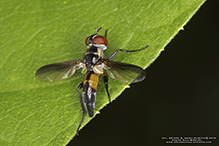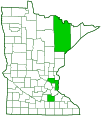Tachinid fly
(Xanthomelanodes arcuatus)
Conservation • Description • Habitat • Ecology • Distribution • Taxonomy
Conservation Status |
|||
| IUCN Red List | not listed |
||
| NatureServe | not listed |
||
| Minnesota | not listed |
||
Description
Xanthomelanodes arcuatus is a small to medium-sized tachinid fly. It occurs in the United States and southern Canada. It is uncommon in Minnesota. There are four species of Xanthomelanodes in North America north of Mexico. Only Xanthomelanodes arcuatus occurs in Minnesota.
Adults are¼″ to 5⁄16″ (6 to 8 mm) in length.
There are two large compound eyes at the side of the head and three small simple eyes (ocelli) in a triangle at the top of the head. The compound eyes are brown. They do not meet at the top of the head in either sex. The antennae have three segments. The second segment has a longitudinal groove (suture) on top. The third segment has a long, forward-pointing bristle (arista) on the upper side. The arista is bare, not feather-like (plumose). The upper face (frons), corresponding to the forehead, is black and relatively narrow, 0.21 times the width of the head. The area between the frons and the compound eye (frontorbital plate) may be white, yellowish-white, or yellow. On each side of the face below the antenna there is a sunken area (parafacial) defined by the inner margin of the compound eye on the outside and an inverted V-shaped groove (ptilinal suture) on the inside. The parafacial is mostly hairless, with at most a few hairs on the upper third. There are two long, stiff bristles (vibrissae) below the antenna bases. The vibrissae arise far above the lower margin of the face. There are long sensory organs (palps) attached to the mouth. The protruding mouthpart (proboscis) is not slender and piercing.
The thorax has three segments. Each segment has four principal exoskeletal plates, one above, one below, and one on each side. The upper (dorsal) plates, from front to rear, are the prescutum, scutum, and scutellum. The prescutum is mostly black with broad, yellow lateral margins and a narrow yellow rear margin. There is a distinct groove (transverse suture) across the thorax separating the prescutum and scutum. The scutum is black, sometimes with a narrow yellow rear margin. The scutellum is black and has several pairs of bristles. The bristles at the base are longer than those at the tip, and are widely divergent from each other. On the underside, the exoskeletal plate on the first segment (prosternum) is bare. The plate on the second thoracic segment (katepisternum) usually has three bristles.
The abdomen is mostly yellow with distinct black markings on the upper (dorsal) side of each segment. The last two segments are sometimes completely or almost completely black.
As with all flies, there is only one pair of wings, the hind wings being reduced to small, knob-like structures (halteres) that are used for balance in flight. The halteres are yellow. At the base of each wing there are two rounded lobes (calypters) that cover the halteres. The calypters are large, conspicuous, and yellow, yellowish-white, or white. The wings are mostly clear but with dark veins and a broad, smoky-brown band on the outer edge (costal margin). The first posterior cell (R5) is closed before the wing tip
The third leg segment (femur) is mostly yellow, blackish-yellow at the tip. The fourth segment (tibia) is mostly blackish-yellow, black at the tip. The last part of the leg (tarsus), corresponding to the foot, is black.
Size
Total length: ¼″ to 5⁄16″ (6 to 8 mm)
Similar Species
Habitat
Ecology
Season
July through August (CCESR)
Behavior
Life Cycle
Larva Food/Hosts
True bugs (Suborder Heteroptera)
Adult Food
Distribution |
||
|
Sources |
|
| 9/30/2025 | ||
Occurrence |
||
Widespread but not common in Minnesota |
||
Taxonomy
Order
Suborder
Brachycera
Infraorder
Cyclorrhapha
Zoosection
Schizophora
Zoosubsection
Calyptratae (Calyptrate Flies)
Superfamily
Oestroidea (Bot Flies, Blow Flies, and Allies)
Family
Subfamily
Phasiinae
Tribe
Gymnosomatini
Genus
Xanthomelanodes
Subordinate Taxa
Synonyms
Ocyptera arcuata
Ocyptera arcuatus
Common Names
This species has no common name. The common name for the family Tachinidae is tachinid flies, and it is applied here for convenience.
Glossary
Arista
A large bristle on the upper side of the third segment of the antenna of a fly. Plural: aristae.
Calypter
On flies: one of two small membranous lobes at the base of the forewing that covers the haltere.
Costal margin
The leading edge of the forewing of insects.
Femur
On insects and arachnids, the third, largest, most robust segment of the leg, coming immediately before the tibia. On humans, the thigh bone.
Frons
The upper front part of an insect’s face, roughly corresponding to the forehead.
Halteres
In flies: a pair of knob-like structures on the thorax representing hind wings that are used for balance.
Ocellus
Simple eye; an eye with a single lens. Plural: ocelli.
Palp
Short for pedipalp. A segmented, finger-like process of an arthropod; one is attached to each maxilla and two are attached to the labium. They function as sense organs in spiders and insects, and as weapons in scorpions. Plural: palpi or palps.
Proboscis
The tube-like protruding mouthpart(s) of a sucking insect.
Scutellum
The exoskeletal plate covering the rearward (posterior) part of the middle segment of the thorax in some insects. In Coleoptera, Hemiptera, and Homoptera, the dorsal, often triangular plate behind the pronotum and between the bases of the front wings. In Diptera, the exoskeletal plate between the abdomen and the thorax.
Scutum
The forward (anterior) portion of the middle segment of the thorax (mesonotum) in insects and some arachnids.
Tarsus
On insects, the last two to five subdivisions of the leg, attached to the tibia; the foot. On spiders, the last segment of the leg. Plural: tarsi.
Tibia
The fourth segment of an insect leg, after the femur and before the tarsus (foot). The fifth segment of a spider leg or palp. Plural: tibiae.
Visitor Photos
Share your photo of this insect.
This button not working for you?
Simply email us at info@MinnesotaSeasons.com.
Attach one or more photos and, if you like, a caption.
Alfredo Colon |
 |
MinnesotaSeasons.com Photos
|

Slideshows

Visitor Videos
Share your video of this insect.
This button not working for you?
Simply email us at info@MinnesotaSeasons.com.
Attach a video, a YouTube link, or a cloud storage link.
Other Videos



